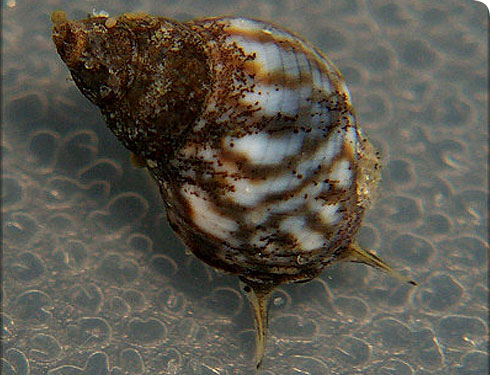Echinolittorina placida
Echinolittorina placida is a marine snail belonging to the family of periwinkles (Littorinidae). It lives on sheltered rocky shores and jetties in the Gulf of Mexico, where it was first discovered in 2009 by Museum scientists (Reid et al, 2009).
In the Gulf of Mexico it is the only common littorinid snail on rocks and jetties. There are other black-and-white striped littorinids elsewhere in the western Atlantic, but only Echinolittorina interrupta, which is found on the continental shore of the Caribbean Sea, shares the spiral black band.
During the twentieth century this species extended its natural range from the north-west Yucatan Peninsula all around the Gulf of Mexico to Florida and North Carolina - an increase of 4,500km of coastline. This is due to human activity and the construction of sea walls and jetties, which has provided new habitats for the snail.
Species detail

Echinolittorina placida
The shell of Echinolittorina placida ranges in size from 3–20mm long and is sculptured by fine spiral lines. The aperture is oval and lacks a ‘spout’ at the blunt end (anterior canal).
The colour pattern is variable. It consists of blue-grey to black diagonal lines or zigzags on a white or pale grey background, with a broad black spiral band running around each whorl. The aperture is dark brown, with a pale spiral band within the anterior part. The head and sides of the foot are black, and each pair of head tentacles bears two longitudinal black lines.
The sexes are separate - in males there is a white penis on the right side behind the head, and this bears one flask-shaped and one flap-like gland on a single side branch.
-

Taxonomy
This snail species was first discovered in 2009 in the Gulf of Mexico. It is the only common littorinid snail to be found on rocks and jetties. Find out more about this periwinkle and its relatives.
-

Distribution and conservation
The range of Echinolittorina placida has expanded enormously in the last 100 years. Humans have unintentionally created new habitats for the snail by constructing sea walls and jetties. Find out more about this snail’s rapid move northwards.
-

Biology
Echinolittorina placida reaches adulthood within a year. Find out how this snail reproduces.
-

Behaviour
Echinolittorina placida feeds by grazing on tiny algae attached to hard surfaces. Discover how the snail copes when the surface dries out.
Distribution map
A world map showing the distribution of Echinolittorina placida
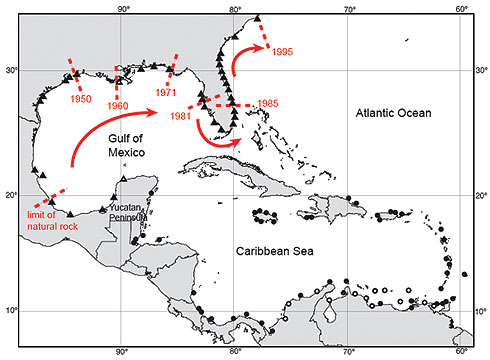
Distribution of Echinolittorina placida - shown here as triangles, and Echinolittorina interrupta - shown as circles.
The filled symbols are Museum records, the open symbols are literature records. Arrows and dates show the expansion of Echinolittorina placida from its original distribution in the southern Gulf of Mexico and Yucatan Peninsula.
Images
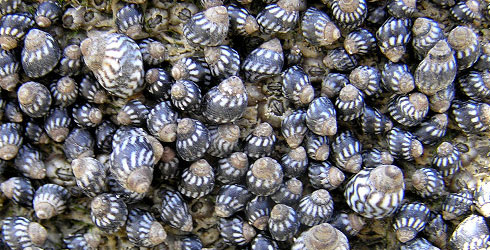
Echinolittorina placida.
© www.jaxshells.org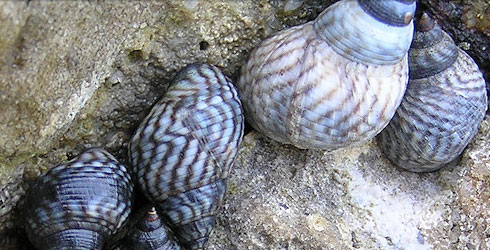
Echinolittorina placida.
© www.jaxshells.org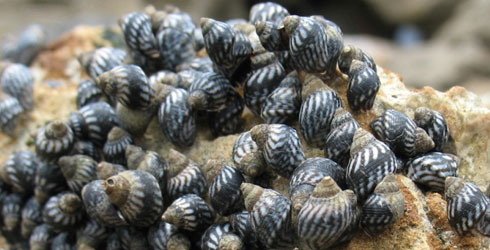
Echinolittorina interrupta at Sebastian Inlet, Florida.
© Marlo Krisberg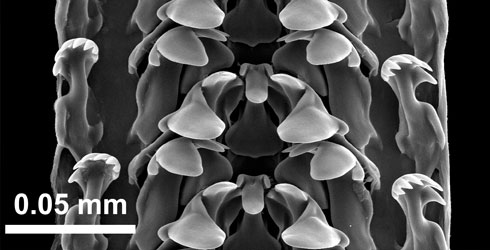
A scanning electron micrograph of a portion (3 tooth rows from a lotal length of 5 mm) of the long radula ribbon of Echinolittorina placida. In life most of the ribbon is coiled inside the buccal mass of the head.

Echinolittorina placida.
A word from the author
"This inconspicuous snail looks a lot like other ‘zebra periwinkles’ in the western Atlantic, and it was a surprise to discover it so recently in a group that we thought was well known. Its dramatic change in distribution is extraordinary, and shows both the importance of historic observations by local naturalists, and the inadvertent effects of human activities on the natural world."
Author

Dr David Reid
Merit Researcher and Leader of the Marine Mollusc Research Group. His research focuses on the systematics and evolution of shallow-water gastropods.
Toolbox
References
Reid, D.G. (2009) The genus Echinolittorina Habe, 1956 (Gastropoda: Littorinidae) in the western Atlantic Ocean. Zootaxa, 2184: 1–103.
